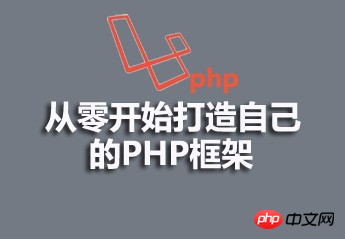 Backend Development
Backend Development
 PHP Tutorial
PHP Tutorial
 Video material on building your own PHP framework from scratch
Video material on building your own PHP framework from scratch
Video material on building your own PHP framework from scratch
你觉得Thinkphp框架很不错?Laravel很优雅?Yii很稳定?CI很高效?哼哼,其实你自己开发的才是最最好用最最适合你的框架!

课程播放地址:http://www.php.cn/course/276.html
该老师讲课风格:
讲课亲切自然,朴实无华,没有矫揉造作,也不刻意渲染,而是娓娓而谈,细细道来,师生之间在一种平等、协作、和谐的气氛下,进行默默的情感交流,将对知识的渴求和探索融于简朴、真实的教学情景之中,学生在静静的思考、默默的首肯中获得知识
本视频中较为难点是配置加载类(1)了:
一、配置加载类
要想做配置加载类我们要先了解为什么要用到配配置加载类
当我们需要改变某一项配置的时候我们不需要在功能中找到所有的配置进行修改,而是直接在一个单独的配置文件中修改,这样可以更好的优化我们的框架,用起来才会更舒服。
比如说我们的数据库配置
我们可以做一个单独的数据库配置文件放到config文件中
<?php
return array(
'DSN' => 'mysql:host=localhost;dbname=test',
'USERNAME' => 'root',
'PASSWD' => 'root'
)
?>接下来让我们加载配置文件
public function __construct(){
$database = conf::all('database');
try {
parent::__construct($database['DSN'],$database['USERNAME'],$database['PASSWD']);
} catch (\PDOException $e) {
p($e->getMessage());
}
}这样的话,我们只需要修改配置文件就可以修改我们的数据库连接岂不是很方便
二、日志类
日志类是所有框架中都必不可少的功能,日志类可能是存在数据库中,也可以存在存在文件中。
在config文件中创建log.PHP配置文件,里面放上文件的存储方式和存储路径
<?php
return array(
'DRIVE' => 'file',
'OPTION' => array(
'PATH' => LHY.'/log/'
)
);
?>在lib文件中创建一个log文件,再从log文件中创建一个file.php文件,在file.php文件中实现将日志存入文件
<?php
namespace core\lib\drive\log;
use core\lib\conf;
class file
{
public $path;#日志存储路径
public function __construct(){
$conf = conf::get('OPTION','log');
$this->path = $conf['PATH'];
}
public function log($message,$file){
$path = $this->path;
// echo $this->path.date('Y-m-d');die;
if(!is_dir($this->path.date('Y-m-d'))){
mkdir($this->path.date('Y-m-d'),0777,true);
}
$message = date('Y-m-d H:i:s').$message;
return file_put_contents($this->path.date('Y-m-d').'/'.$file.'.php',json_encode($message).PHP_EOL,FILE_APPEND);
}
}
?>在lib文件中创建log.php类文件
<?php
namespace core\lib;
use core\lib\conf;
class log
{
static $class;
/**
* 1.确定日志存储方式
*
* 2.写日志
*/
static public function init(){
//确定存储方式
$drive = conf::get('DRIVE','log');
$class = '\core\lib\drive\log\\'.$drive;
self::$class = new $class;
}
static public function log($message,$file){
//core\lib\drive\log\log;
self::$class->log($message,$file);
}
}
?>The above is the detailed content of Video material on building your own PHP framework from scratch. For more information, please follow other related articles on the PHP Chinese website!

Hot AI Tools

Undresser.AI Undress
AI-powered app for creating realistic nude photos

AI Clothes Remover
Online AI tool for removing clothes from photos.

Undress AI Tool
Undress images for free

Clothoff.io
AI clothes remover

AI Hentai Generator
Generate AI Hentai for free.

Hot Article

Hot Tools

Notepad++7.3.1
Easy-to-use and free code editor

SublimeText3 Chinese version
Chinese version, very easy to use

Zend Studio 13.0.1
Powerful PHP integrated development environment

Dreamweaver CS6
Visual web development tools

SublimeText3 Mac version
God-level code editing software (SublimeText3)

Hot Topics
 1375
1375
 52
52
 PHP 8.4 Installation and Upgrade guide for Ubuntu and Debian
Dec 24, 2024 pm 04:42 PM
PHP 8.4 Installation and Upgrade guide for Ubuntu and Debian
Dec 24, 2024 pm 04:42 PM
PHP 8.4 brings several new features, security improvements, and performance improvements with healthy amounts of feature deprecations and removals. This guide explains how to install PHP 8.4 or upgrade to PHP 8.4 on Ubuntu, Debian, or their derivati
 CakePHP Working with Database
Sep 10, 2024 pm 05:25 PM
CakePHP Working with Database
Sep 10, 2024 pm 05:25 PM
Working with database in CakePHP is very easy. We will understand the CRUD (Create, Read, Update, Delete) operations in this chapter.
 CakePHP Date and Time
Sep 10, 2024 pm 05:27 PM
CakePHP Date and Time
Sep 10, 2024 pm 05:27 PM
To work with date and time in cakephp4, we are going to make use of the available FrozenTime class.
 CakePHP File upload
Sep 10, 2024 pm 05:27 PM
CakePHP File upload
Sep 10, 2024 pm 05:27 PM
To work on file upload we are going to use the form helper. Here, is an example for file upload.
 CakePHP Routing
Sep 10, 2024 pm 05:25 PM
CakePHP Routing
Sep 10, 2024 pm 05:25 PM
In this chapter, we are going to learn the following topics related to routing ?
 Discuss CakePHP
Sep 10, 2024 pm 05:28 PM
Discuss CakePHP
Sep 10, 2024 pm 05:28 PM
CakePHP is an open-source framework for PHP. It is intended to make developing, deploying and maintaining applications much easier. CakePHP is based on a MVC-like architecture that is both powerful and easy to grasp. Models, Views, and Controllers gu
 CakePHP Creating Validators
Sep 10, 2024 pm 05:26 PM
CakePHP Creating Validators
Sep 10, 2024 pm 05:26 PM
Validator can be created by adding the following two lines in the controller.
 CakePHP Logging
Sep 10, 2024 pm 05:26 PM
CakePHP Logging
Sep 10, 2024 pm 05:26 PM
Logging in CakePHP is a very easy task. You just have to use one function. You can log errors, exceptions, user activities, action taken by users, for any background process like cronjob. Logging data in CakePHP is easy. The log() function is provide



